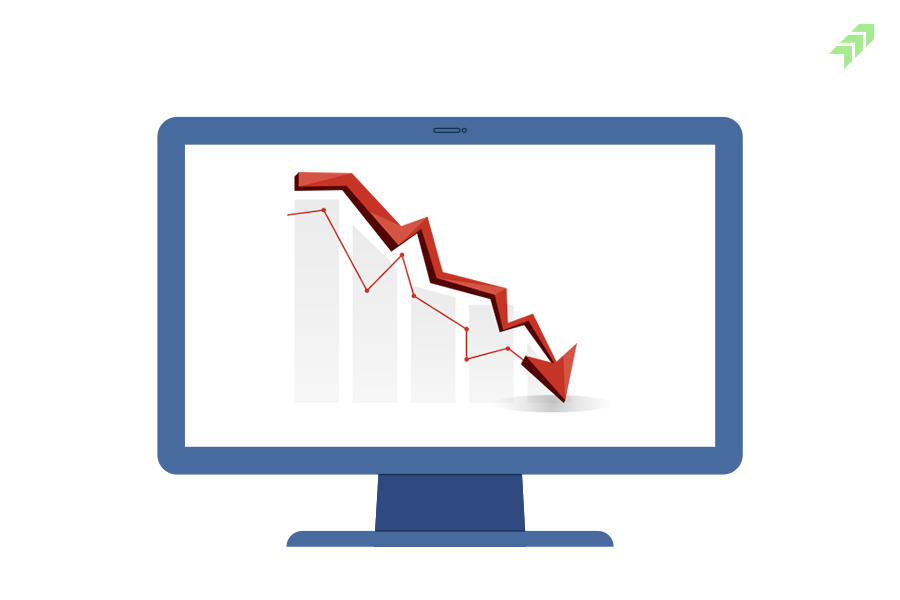Moving Averages is another important technical indicator used by the traders while taking the buying and selling decision in stocks. From long-term trading to short-term and intraday trading, moving averages can be used to get a comparative idea about its historical price movement and latest price to decide whether to buy, sell or hold the stock.
Understanding the moving averages precisely to make the right decision for trading is important to utilize the power of this technical indicator. There are different types of moving averages applied in hourly, daily, weekly and monthly charts as per the trading strategy of the trader. Thus, in this article, we will discuss about moving averages, how to use them in trading with crossover strategy and various other aspects making it easier to understand the use of this tool.
What is the Moving Average Indicator?
Moving average is simply a stock indicator in technical analysis, showing the average price of stock over a period giving an idea of how much stock is trading above, below or close to its moving average price. The average price can be taken for a period like 10 days, 20 minutes, 30 weeks, or any period as per the trader’s choice and types of moving averages.
Also Read: Technical Analysis vs Fundamental Analysis: Which is Better
There basically, are three types of moving averages weighted moving average (WMA), the simple moving average (SMA), and the exponential moving average (EMA). All these indicators can be applied initially, in tandem, or combination with other important moving averages, such as the Moving Average Convergence Divergence (MACD).The procedure of calculating all these moving averages is different from each other, let’s find out.
How to Calculate Four Point Moving Averages?
In calculating the moving average you need to understand these moving averages. The simple moving average is simply the average price of the stock over some time. For example, you can take 10-days, 20-days, 50-days, 100-days, or 200-days, period and add the daily closing price of the stock for that period and divide the same by the number of days you have taken to find out the simple moving average.
While, in the exponential moving average, you have to give more weight to more recent data that will track prices more closely than the related SMA. The most common EMA periods traders utilize are 50-days, 100-days, and 200-days periods if they look at stock from a long-term perspective and 12-day and 26-day EMAs if looking for short-term investment.
Lastly, the weighted moving average which is similar to the SMA, only prioritizes given to each preceding data with a different priority. This allows traders to create a customized weighting algorithm with non-linear distributions. WMA helps to track prices more closely than SMA and can be used to highlight support and resistance levels or identify the trend direction.
How to Use Moving Averages to Find the Trend?
Before buying any stock, first of all, you need to know the trend of the stock whether it is in a bullish trend, bearish trend or in a sideways trading range. According to the trend of a stock, you can decide to create a buying or selling position in any stock.
Using the moving average to find the trend, you have to plot a single moving average on the chart of the stock price you are looking to buy or sell. In today's technological era, you don't need to calculate the moving average values, when you use an advanced technical chart like candlestick chart patterns on your computer screen, in-built tools of technical indicators are available there you just need to select the desired one and apply on the chart.
Also Read: How to Read, Analyse& Use Candlestick Chart Patterns for Trading
You can also customize the parameters like the number of trading days, and apply the desired tool to draw that indicator. Similarly, you can draw the moving average as per your preferred period like 20-days, 50-days or 200-days. When you draw the MA line on the chart you can see a trend line is visible around the chart patterns showing the current trend in the stock.
When price action inclines to stay above the moving average, it indicates that the price is in an uptrend. On the other hand, when price action leans towards below the moving average, it signals that there is a downtrend in the stock. But don't rely on the single parameters, use a couple of more moving averages like short-term period moving average and long-term period moving average both can be drawn on the same chart to get a more precise trend.
Apart from checking the slope of the MA, you can compare the position of the price relative to the MA, if the price is trailing above the MA, it confirms an uptrend; while the price trailing below the MA, it confirms that there is a downtrend. You can also use the crossovers of two MAs, in which if a shorter-term MA crosses above a longer-term MA, it signals a bullish trend reversal, while a shorter-term MA crosses below, it indicates a bearish trend reversal.
How to Use Moving Averages as Support and Resistance?
In trading finding the support and resistance describes the levels where the price of stock is more likely to stop moving in one direction or change the direction. At support levels, the price might reverse and move higher or you can say at this point the moving down momentum of price slowdowns. While at resistance levels, the price might reverse and move lower or at this point the momentum of the price moving up side is slowdowns.
You can use the moving averages of different periods to indicate levels of support and resistance. Usually, Moving averages running below the price create a support level and moving averages trailing above the price build a resistance level. You can add more than one-period moving average to find out more precise levels of support and resistance. For example, you can apply the 20, 50 and 100 days exponentially moving averages on the charts.
Also Read: Support and Resistance: How to Find Support & Resistance
Using a shorter-period moving average gives support or resistance levels weaker than a long-period moving average. For example – a 100-day moving average provides a stronger support point compared to 10 days moving average.
Hence, use the different period moving averages like 10-days, 20-days, 50-days, 100-days and 200-days moving averages according to chart timings like hourly, daily, weekly or monthly. You can use the 100-days moving average on the daily chart to get the long-term stronger support and resistance where the price might move this far around every month.
At the support or resistance point, the moving average can be used to locate the areas that the price could move through or bounce back.
However, if the price moves to the moving average and does not bounce, there is a higher chance that it will move to lower levels of support. If the price has already reached at lower levels of support, let's say around 200-days moving average, then it signals a longer-term change in the trend. This indicates, that there is a chance the stock price is moving from an uptrend to down downtrend and vice versa or this phase is called the trend reversal.
Moving Averages in Trading
The main motive for using the moving averages is to find the trend and support or resistance on the price chart to create the right strategy for trading in that stock. You can combine all these signals, like trend, support or resistance to develop a profitable trading strategy for intraday trading or buy the stocks from a long-term investment point of view.
From simple moving averages to exponential moving averages or weighted average moving averages, apply them on daily charts and compare short, medium, and long-term trends over large periods. You have to use the right time frame to draw the moving average with a combination of short-period to long-period moving averages as per the trend line support or resistance.
Moving Average Trading Strategy
The trading strategy depends on your investment time horizon, yes are you going to use the moving average for intraday trading, for medium-term investment or for long-term investment. According to that, you have to choose the right parameter like the duration of the chart and apply the right duration moving average on that chart to get accurate results. Hence, below we brought the moving average trading strategy used by the traders globally.
Also Read: How to Select Stocks for Intraday: 10 Tips to Pic Best Stocks
Right Time Frame: Choose the right time frame to draw the moving average line, a shorter day moving average will be more sensitive towards price movement, compared to a longer period moving average that gives a stronger indication of the underlying trend and is more suitable for short-term trading and investing for long-term.
Also Read: Trading or Investing Which is Better and More Profitable
A 10-days moving average trend line will be closer to price movement compared to 50-days moving average, and 200-days moving average will be smoother compared to these short-term and medium-term moving average periods.
Identify the Trend: The main use of moving averages in trading is finding the trend in the stock price. When you see the price trading above the MA, it indicates there is potential for an uptrend. On the other hand, when the price moves below the moving average, means it indicates a downtrend. Moreover, you can use the slope of the MA line to know the momentum of the trend.
Determine the Support & Resistance: As we already discussed, MA acts like a dynamic support and resistance level. When stock is in an uptrend, MA works like a support level, where the price inclines to bounce back and continue the upward movement.
While in a downtrend, the MA works as resistance levels, stopping the price from reversing back into the downward trajectory. In trading, you can use the support and resistance as a stop-loss, entry point exit or book profits around these levels.
Also Read: What is Profit Booking in Stock Market: Rules & Best Strategy
MA Crossover Strategy: Apart from the bullish and bearish crossover, MA crossover happens when a short-period simple moving average crosses over a long-period simple moving average. Moving-average crossovers examples are Golden cross and Death cross.
When a 50-days simple moving average rises above the 200-day simple moving average, it is called the golden cross which is a bullish signal. When the 50-day simple moving average falls below the 200-day simple moving average it is known as the death cross giving a bearish signal in the stock that can further fall in the upcoming period.
MA using the Bollinger Bands: You can use another feasible trading strategy using the 20 days MA with Bollinger bands. This strategy is known as mean reversion using Bollinger bands, in which when the price will often return to the mean before bouncing back in the direction of the trend. Here, the middle Bollinger band (the 20-day SMA) can be used as support or resistance that can provide a useful buying and selling tool to form the right trading strategy.
Also Read: Bollinger Bands: Indicator, Strategy, Settings& Analysis
How to Use Moving Averages for Swing Trading?
In swing trading, traders consider various factors and use technical indicators like moving averages to select the stocks for short-term trading. Swing trading helps to pick the stock that has the potential to move or is likely to swing in the market.
And moving average can be used as stop-loss levels for swing trading just above or below the MA. You have to choose the right moving average period for swing trading. 21-days, 50-days, 100-days and 200-days are the most popular duration for moving average.
However, the 50-days moving average is the best one suitable when deciding the short-term or long-term investment. In swing trading strategies indicators, along with moving average, you can also use Fibonacci retracement, support & resistance, RSI and moving average convergence divergence to get the indication of the trend and reversal of the trend to make the right trade decision.
Also Read: How to Use Fibonacci Retracement for Trading: Setting & Strategy
How to Read Moving Average Convergence Divergence?
Moving average Convergence Divergence or MACD is a useful indicator that shows the relationship between two exponential moving averages (EMAs) of a stock price.You can calculate MACD line by deducting the 26-period EMA from the 12-period EMA.
On the MACD chart, a nine-period EMA of the MACD itself is also plotted, which is called the signal line and acts as a trigger point for buying and selling the stock. You can buy the stock if the MACD line crosses above the signal line and sell the stock if the MACD line crosses below the signal line. You can interpret the MACD indicator but the most common methods are crossovers and divergences.
Signal Line Crossover: In MACD, the signal line shows the moving average lines and the intersection of two lines indicates the possibility of significant movement. When short-term EMA crosses above the long-term EMA, it is called a bullish crossing. While, on the other hand when the short-term EMA crosses below the long-term EMA, it is called a bearish crossing.
Also Read: Best Option Strategy for Bearish Market: 7 Option Strategies
Zero Line Crossover: Here again the MACD line, instead of crossing the signal line, crosses the zero level. It means giving the bullish signal when turns positive. When this line crosses the zero line in the downward direction and becomes negative it means MACD indicates a bearish trend. And the trend will be stronger if it is further away from the zero line.
Summing-up
Moving average in trading can be used in combination with various other technical indicators, like RSI, Support Resistance and Swing Trading to get the trend in stock and get the buying or selling signals. Depending on the investment time horizon or trading period, you can choose the right period moving average to know the trend in the stock.
Also Read: Top 5 Best Technical Indicators for Intraday or Day Trading
A shorter-period moving average is closer or sensitive towards the stock price compared to a longer-period moving average. However, for short-term trading short-duration moving averages are more suitable and long-duration MA are good for long-term investment decisions. While combination of both can give you the trend reversal signals in stock.
Exponential moving averages respond faster to change in price than simple moving averages. Moving averages with a shorter period like 20 day swill also respond faster to price changes than an average with a longer period like 200-days MA.
Basically, when the stock price is trading above the EMA, the outlook is bullish, while when the stock price is below the EMA, the outlook turns bearish. And when short-period MA crosses and above the long-period MA, it gives a bullish and bearish if the short-period MA goes below the long-period MA. The longer the time frame you choose for a crossover system, the trading signals will be also slower and here you need an expert to make better use of MV for trading.
Moneysukh, is one of India's leading broking houses, providing the investment and trading solution for equity, currency and commodity markets. Providing all the facilities for individual retail as well as HNI clients to open their trading account and demat account here and enjoy unlimited trading in stocks, commodities or in forex trading.
Also Read: Advantages and Disadvantages of Forex Trading: How to Start
Here, you will also get stock buying tips for intraday, short-term trading and long-term investment in the equity cash market and derivatives (future & options) market with updates and alerts to buy, sell, hold or book the profits in stock on your mobile and mail IDs.
Also Read:7 Biggest Mistakes To Avoid While Doing Intraday Trading
Moneysukh is also one of the best Algo trading platforms to utilize the power of high-frequency trading and perform a high number of trades from anywhere on their desk at the fastest speed to generate higher profits in less time. Anyone looking to open a trading or demat account can contact us and can enjoy unlimited trading at low pricing.
Also Read: How to Start Algo Trading in Moneysukh: A Best Algo Trading Platform



















No comment yet, add your voice below!